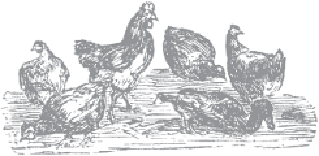Agriculture Reference
In-Depth Information
28
Calendar Considerations
IT'S IMPOSSIBLE TO PINPOINT
an exact time for each event that fills a year, but you can
refer to guidelines to better understand the life cycles of poultry, and to know where you
can and should step in. You can expect these things to happen to your birds and you need
to be prepared for them.
The Poultry Bio Cycle
All poultry have biorhythms that coincide with specific natural weather and light condi-
tions. Human raisers often interfere with these natural rhythms. They supplement their
operations with artificial light, and they heat or cool facilities to produce more eggs and
meat, or to speed up the process. The more humans meddle — trying to control the
growth and lay rates with artificial means — the more the natural biorhythms get out of
sync, requiring ever more human involvement and costly, unsustainable inputs.
Every poultry species is genetically coded for developmental changes, such as mating,
laying, and molting, and all of these are triggered by natural seasonal conditions. When
allowed to do things on their natural schedule, fowl are far thriftier than when living in
an artificially altered world.
Laying
The first event to prepare yourself, your birds, and their facilities for is laying time.
Chickens lay their first eggs when they are between 20 and 24 weeks old. Some of the
modern hybrid sex-links lay when they are as young as 16 weeks. If you live in the north-
ern United States or Canada, where the days get shorter in the fall more rapidly than in
the southern states, you'll have a problem with a short egg-laying season. The January or
February hatched chicks, perhaps purchased for 4-H purposes, may begin to lay as early
as July. They'll lay for a couple of months and then stop suddenly because the length of

